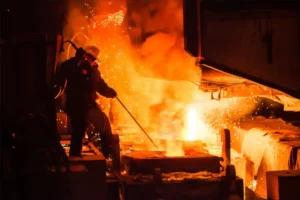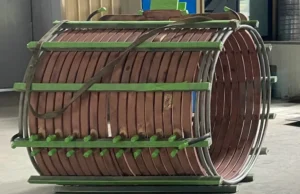Empat metode memanaskan logam dengan energi listrik
Pemanasan resistensi
Pemanasan resistansi adalah metode yang menggunakan resistansi bahan logam itu sendiri untuk menghasilkan efek termal, mengubah energi listrik menjadi energi panas untuk memanaskan logam.
Prinsip: Tambahkan elektroda ke kedua ujung logam untuk membentuk jalur hubung singkat dan sambungkan ke catu daya. Ketika arus mengalir melalui bagian dalam logam, panas dihasilkan karena hilangnya energi.
Skenario yang berlaku: cocok untuk logam dengan ukuran kecil dan bentuk sederhana, terutama di mana pemanasan lokal diperlukan.
Pemanasan Induksi
Pemanasan induksi mengacu pada metode pemanasan listrik yang menghasilkan energi panas melalui arus induksi elektromagnetik (arus eddy).
Prinsip: Ketika arus bolak-balik melewati kumparan (induktor) dari tungku induksi, medan magnet bolak-balik tereksitasi di sekitarnya, melewati bahan logam yang dipanaskan di tungku, menghasilkan gaya gerak listrik yang diinduksi di dalamnya, sehingga menghasilkan arus induksi yang kuat. Sebab bahan metal sendiri mempunyai ketahanan, energi listrik diubah menjadi energi panas untuk mencapai tujuan pemanasan.
Jenis: Menurut frekuensi catu daya, peralatan pemanas induksi dibagi menjadi tungku induksi frekuensi tinggi, tungku induksi frekuensi menengah, dan tungku induksi frekuensi daya. Tungku frekuensi tinggi terutama digunakan untuk perlakuan panas logam, peleburan baja khusus dan paduan khusus; tungku induksi frekuensi menengah terutama digunakan untuk peleburan baja khusus, paduan magnetik, dll., dan sintering logam tahan api atau bahan non-logam; tungku frekuensi daya terutama digunakan untuk peleburan logam. dan isolasi.
Pemanasan Busur
Busur listrik antara dua elektroda menghasilkan panas yang hebat, yang dapat melelehkan logam, dibandingkan dengan metode pemanasan listrik lainnya, pemanasan busur dapat mencapai suhu yang sangat tinggi (misalnya di atas 3000°C)
Pemanasan Dielektrik
Pemanasan dielektrik menggunakan sifat dielektrik material untuk menghasilkan panas ketika terkena medan listrik. Meskipun lebih umum digunakan pada bahan non-logam seperti plastik atau makanan, itu juga dapat diterapkan dalam proses pemanasan logam tertentu, terutama pada material komposit atau ketika logam merupakan bagian dari sistem yang lebih besar dengan komponen non-logam.

Mengapa memilih pemanas logam listrik?
Presisi Terkendali:
Atur dan pertahankan suhu spesifik untuk logam Anda, memastikan pemanasan seragam tanpa titik panas atau inkonsistensi.
Efisiensi:
Penerapan langsung panas listrik meminimalkan pemborosan energi, menjadikan prosesnya lebih ramah lingkungan dan hemat biaya.
Kemampuan beradaptasi:
Dari proyek penghobi skala kecil hingga industri manufaktur, sistem pemanas logam listrik hadir dalam berbagai ukuran dan konfigurasi untuk memenuhi kebutuhan Anda.

Memilih peralatan yang tepat
Jenis Logam:
Logam yang berbeda memiliki sifat hambatan listrik yang berbeda-beda, jadi pilihlah peralatan yang cocok untuk logam tertentu yang Anda gunakan.
Kisaran Suhu:
Pastikan kemampuan suhu peralatan selaras dengan persyaratan proyek Anda.
Ukuran dan Kapasitas:
Pertimbangkan ukuran dan jumlah potongan logam yang ingin Anda panaskan untuk memilih sistem pemanas dengan ukuran yang tepat.
——Tanggal rilis pertama: Desember 8, 2023







